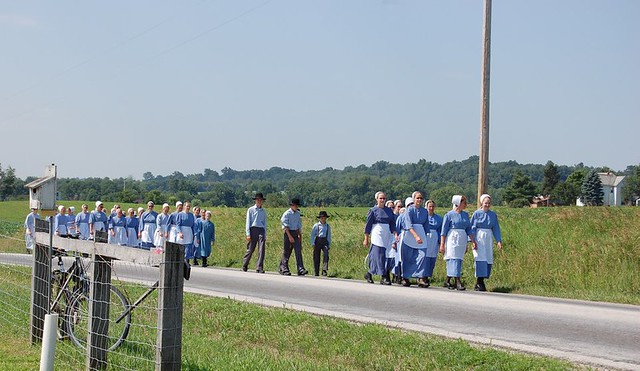Let me start by saying that each Amish
community has their own special traditions, what I have written is indicative
of a typical Amish community in Ohio or Pennsylvania. The information below is from www.PaDutchCountry.com and www.OhiosAmishCountry.com.
Courtship, meaning serious dating leading
to marriage, among the Amish is secretive. A couple doesn’t announce their
engagement until just a few weeks before their wedding. They keep it a secret
(as long as they can). An Amish wedding is a particularly joyous occasion, for two
baptized members of the church are joining in marriage, continuing the faith
and starting a new family together. While parents do not select who their
children will marry, approval must be given, and the deacon usually acts as the
go-between. At a church service, the couples planning to marry are
"published," or announced in front of the congregation. But much
preparation, mainly by the bride’s parents, has already begun, including in
some Amish communities, the early summer planting of several hundred stalks of
celery, an important part of some Amish wedding feasts. Stalks of celery are used as table
decorations as well as being served as creamed celery casseroles.
It is always an occasion for a new dress
for the bride. Brides typically don't wear white but one of the more acceptable
colors of their group, normally a beautiful shade of blue. They take great care
in choosing the fabrics and colors of their wedding party. The wedding party,
called attendants in Englisch ceremonies, are all dressed in the same dress
color. The young men of the wedding party also wear matching shirts in some
cases. The servers, who assist at the meal, also have special colors that the
bride picks for them to wear.
Amish weddings take place during a
service similar to the typical Amish worship service held every other Sunday.
The Bishop and ministers preside. The couple takes their vows before the church. Most Amish
weddings take place after the autumn harvest, from late October through
December. Traditionally, they are held on Tuesdays and Thursdays, so there is
time in between to get ready for and clean up after each. Even so, it can get
pretty busy during the "wedding season," with some Amish going to two
or three weddings in one day! Recently
some Amish communities have gone to springtime weddings as well since the fall
wedding season has gotten overbooked.
After the church wedding, the celebration
continues with the meal. The Amish wedding meal is usually typical fare with
fried or broasted chicken, mashed potatoes and gravy, dressing, coleslaw,
creamed celery, applesauce, and other vegetables. Among the
desserts are pies, doughnuts, fruit, and pudding. There are usually several
wedding cakes, some made by the women, but often one from a bakery as well, which
are usually eaten later in the day. It will take several seatings to feed
200-300 (or more) guests. It is not unheard of for there to be 500 guests at an
Amish wedding. After the meal, in some groups, the bride
and groom visit the wedding meal guests with baskets of candy to hand out as
favors. This gives them an opportunity to greet all the guests personally. In
the afternoon, the young people have a singing, and soon it is time for those
who have stayed through the day to enjoy the evening meal. Hymn-singing again
follows the meal, dominated by "faster hymns" which the youths enjoy.
In some groups, the parent's will give their newlyweds their first bedroom suite, handmade by the family or by another craftsman in the community. After spending the night at the bride’s home, the newlyweds awake the next day to begin helping with the clean-up from the day before. The couple will spend upcoming weekends visiting relatives, sometimes stopping at five or six houses between a Friday and Sunday night. Wedding gifts are usually given to them at this time.
Many times the couple will set up
housekeeping with one of the parents until they are financially ready to either
buy, rent, or build a new home. Usually
within six months, the couple is ready to move into a home of their own, and the
groom will have begun growing his beard.
This is an Amish tradition that signifies a man is married. There is no exchanging of rings; the Amish do
not wear any type of jewelry.
The wife may continue to work part time
outside the home, continuing her cleaning business or working in a local
establishment. But they soon retire to begin their family. With no dishwashing machine, automatic
washer/dryer, and other time saving electrical devices, it takes a full time
housekeeper to keep the household running.
Most Amish housewives keep a large vegetable garden, put up jars of
jelly, jam, vegetables, cooked meats, pie fillings, relish (chow-chow), and
fruits, keep a spotless home, quilt, sew their family’s clothes, cook large
meals three times a day, and manage a large family. It is no wonder that the majority of married
women do not work outside the home.
As a final note, Amish marriages are
until death we do part, there is no divorce.
Widows and widowers are free to remarry and are encouraged to do
so. Couples can live apart, but
regardless of the reason, there is no divorce and remarriage for the
Amish.




Great post! So interesting to see how different communities celebrate the sacrament of marriage.
ReplyDeleteExcellent and Interesting Information/Post. I enjoyed reading it. Thank You for sharing
ReplyDelete